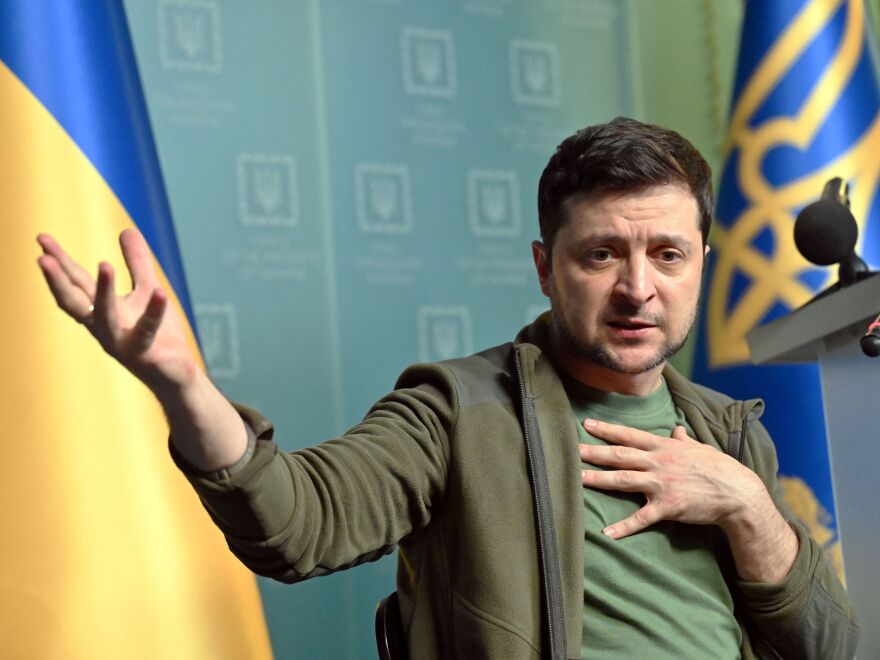Updated March 22, 2022 at 8:44 AM ET
A designer coat President Vladimir Putin wore last week during a rare public appearance has turned the Russian leader into a meme and a source of derision at a time when Ukraine's Volodymyr Zelenskyy's understated fashion choices have helped transform him into a wartime hero.
The blue coat underscores how Putin is out of touch with ordinary Russians and is yet another example of the information war he's engaged in, fashion experts and historians contend.
The coat, which was reportedly fabricated in Italy and cost approximately $14,000, is part of the carefully curated way Putin attempts to present himself to the world, said Marlen Komar, a fashion history journalist.
The coat is a strategic part of Putin's propaganda machine which operates day and night to combat reports portraying Russia "as a poor, suffering country that is on the brink of collapse behind its exterior image," Komar told NPR over email.
Zelenskyy, on the other hand, knows exactly what he's doing in his simple green T-shirts and other military garbs, said Dr. Kimberly Chrisman-Campbell, a fashion historian and author of "Red, White, and Blue on the Runway: The 1968 White House Fashion Show and the Politics of American Style."

All clothing choices are a form of communication and both leaders are "extremely conscious of the political power of image, even if they use that power in very different ways," Chrisman-Campbell told NPR over email.
"By wearing T-shirts and hoodies, the youthful, egalitarian uniform of Silicon Valley, rather than suits, Zelenskyy is projecting confidence and competence in a modern way, to a younger, global audience that recognizes it as such," Chrisman-Campbell said. "He is probably more comfortable than Putin on camera, too, both as an actor and as a digital native. ... I believe both of them want to come across as relatable, not aloof or untouchable, although Zelenskyy is definitely doing a better job balancing authority with accessibility."
When you lead a country, a shirt is more than just a shirt
Zelenskyy is far from the first world leader to adopt a sartorial combat stance in wartime.
These sorts of fashion choices are not just acceptable; they are appropriate and even useful, Chrisman-Campbell said.

"Winston Churchill went all-in on the siren suit, a one-piece romper you could zip on quickly in case of an air raid, during World War II," she said. "He had his tailor make them in luxury fabrics like pinstriped wool and velvet, but he wore them to official venues including the White House and the Kremlin. Like Zelenskyy's Army green T-shirts and flak jackets, they were visual reminders of the ongoing war, aimed at a global audience."
President Franklin D. Roosevelt wore a Navy boat cloak to the Yalta Conference in February 1945, giving him a military appearance at a time many Americans were in uniform, she said.
Putin's choice bucks the trend
When placed in historical context, it's odd to see Putin wearing a coat from an Italian designer, said Dr. Virginia Olmsted McGraw, a visiting assistant professor at Colby College and who studies Soviet culture and fashion.
During times of austerity, most government leaders are careful to wear domestically produced clothing. Regardless of the cost of those clothes, buying domestic brands reflects pride in local production and that the leader is concerned about keeping money within the country, McGraw told NPR over Twitter.
For example, while Nikita Khrushchev, who led the Soviet Union from 1953-1964, wore Italian suits, much like Putin does, Leonid Brezhnev, one of Khrushchev's proteges, had a personal Soviet designer, McGraw said.
While his clothing was custom made and substantially higher quality than almost anyone else in the country, Brezhnev knew it was important domestically and internationally to say that his clothing was made in the USSR, McGraw added.
"Since Soviet consumer goods were frequently mocked on the international market, it was important that Brezhnev show his commitment to Soviet production," McGraw said. "Mikhail Gorbachev and his wife Raisa Gorbacheva also made a conscious effort to wear Soviet-designed and produced clothing. This history makes Putin's choice of not only an expensive jacket, but a jacket from his favorite Italian brand, that much more striking and tone-deaf. A Russian-designed coat would have better reinforced his message of Russian nationalism and undercut much of this criticism."
Copyright 2022 NPR. To see more, visit https://www.npr.org.



